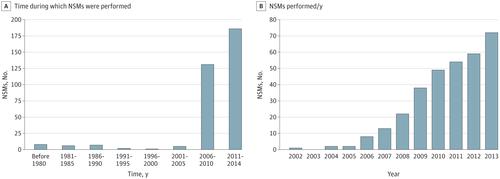JAMA Surgery ( IF 16.9 ) Pub Date : 2018-02-01 , DOI: 10.1001/jamasurg.2017.3422 James W. Jakub 1 , Anne Warren Peled 2 , Richard J. Gray 3 , Rachel A. Greenup 4 , John V. Kiluk 5 , Virgilio Sacchini 6 , Sarah A. McLaughlin 7 , Julia C. Tchou 8 , Robert A. Vierkant 9 , Amy C. Degnim 1 , Shawna Willey 10

|
Importance Nipple-sparing mastectomy (NSM) offers superior cosmetic outcomes and has been gaining wide acceptance; however, its role among patients with BRCA mutations remains controversial.
Objective To report on the oncologic safety of NSM and provide evidence-based data to patients and health care professionals regarding preservation of the nipple-areolar complex during a risk-reducing mastectomy in a population with BRCA mutations.
Design, Setting, and Participants We retrospectively reviewed the outcomes of 9 institutions’ experience with prophylactic NSM from 1968 to 2013 in a cohort of patients with BRCA mutations. Patients with breast cancer were included if they underwent contralateral risk-reducing mastectomy; however, only the prophylactic side was considered in the analysis. Patients found to have an occult primary breast cancer at the time of risk-reducing mastectomy, those having variant(s) of unknown significance, and those undergoing free nipple grafts were excluded.
Main Outcomes and Measures The primary outcome measure was development of a new breast cancer after risk-reducing NSM. Three reference data sources were used to model the expected number of events, and this was compared with our observed number of events.
Results A total of 548 risk-reducing NSMs in 346 patients were performed at 9 institutions. The median age at NSM was 41 years (interquartile range, 34.5-47.5 years). Bilateral prophylactic NSMs were performed in 202 patients (58.4%), and 144 patients (41.6%) underwent a unilateral risk-reducing NSM secondary to cancer in the contralateral breast. Overall, 201 patients with BRCA1 mutations and 145 with BRCA2 mutations were included. With median and mean follow-up of 34 and 56 months, respectively, no ipsilateral breast cancers occurred after prophylactic NSM. Breast cancer did not develop in any patients undergoing bilateral risk-reducing NSMs. Using risk models for BRCA1/2 mutation carriers, approximately 22 new primary breast cancers were expected without prophylactic NSM. Prophylactic NSM resulted in a significant reduction in breast cancer events (test of observed vs expected events, P < .001).
Conclusions and Relevance Nipple-sparing mastectomies are highly preventive against breast cancer in a BRCA population. Although the follow-up remains relatively short, NSM should be offered as a breast cancer risk–reducing strategy to appropriate patients with BRCA mutations.
中文翻译:

患有BRCA突变的人群中预防性保留乳头乳房切除术的肿瘤学安全性多机构研究
重要性 保留乳头的乳房切除术(NSM)可提供出色的美容效果,并已获得广泛认可。然而,其在BRCA突变患者中的作用仍存在争议。
目的 报告NSM的肿瘤学安全性,并为患者和医疗保健专业人员在BRCA突变人群中降低风险的乳腺切除术中乳头-乳晕复合物的保存提供循证数据。
设计,设置和参与者 我们回顾性回顾了1968年至2013年间9所机构在一组BRCA突变患者中预防性NSM经验的成果。如果乳腺癌患者接受了降低对侧风险的乳房切除术,则将其包括在内;但是,在分析中仅考虑了预防方面。在降低风险的乳腺切除术中发现患有隐匿性原发性乳腺癌的患者,具有未知意义的变体和进行游离乳头移植的患者被排除在外。
主要结果和措施 主要结果指标是降低风险的NSM后发生新的乳腺癌。使用三个参考数据源对事件的预期数量进行建模,并将其与我们观察到的事件数量进行比较。
结果 在9家机构中,共346例患者中执行了548种降低风险的NSM。NSM的中位年龄为41岁(四分位间距为34.5-47.5岁)。202例患者(58.4%)进行了双侧预防性NSM,144例患者(41.6%)进行了对侧乳癌继发于癌症的单侧降低风险的NSM。总体上,包括201例BRCA1突变的患者和145例BRCA2突变的患者。中位和平均随访分别为34和56个月,预防性NSM后未发生同侧乳腺癌。接受双侧降低风险的NSM的任何患者均未发生乳腺癌。对BRCA1 / 2使用风险模型突变携带者中,预计约有22种新的原发性乳腺癌没有预防性NSM。预防性NSM导致乳腺癌事件显着减少(观察到的预期事件检验,P <.001)。
结论和相关性 保留乳头的乳房切除术在BRCA人群中对乳腺癌具有高度的预防作用。尽管随访时间相对较短,但应为适当的BRCA突变患者提供NSM作为降低乳腺癌风险的策略。



























 京公网安备 11010802027423号
京公网安备 11010802027423号